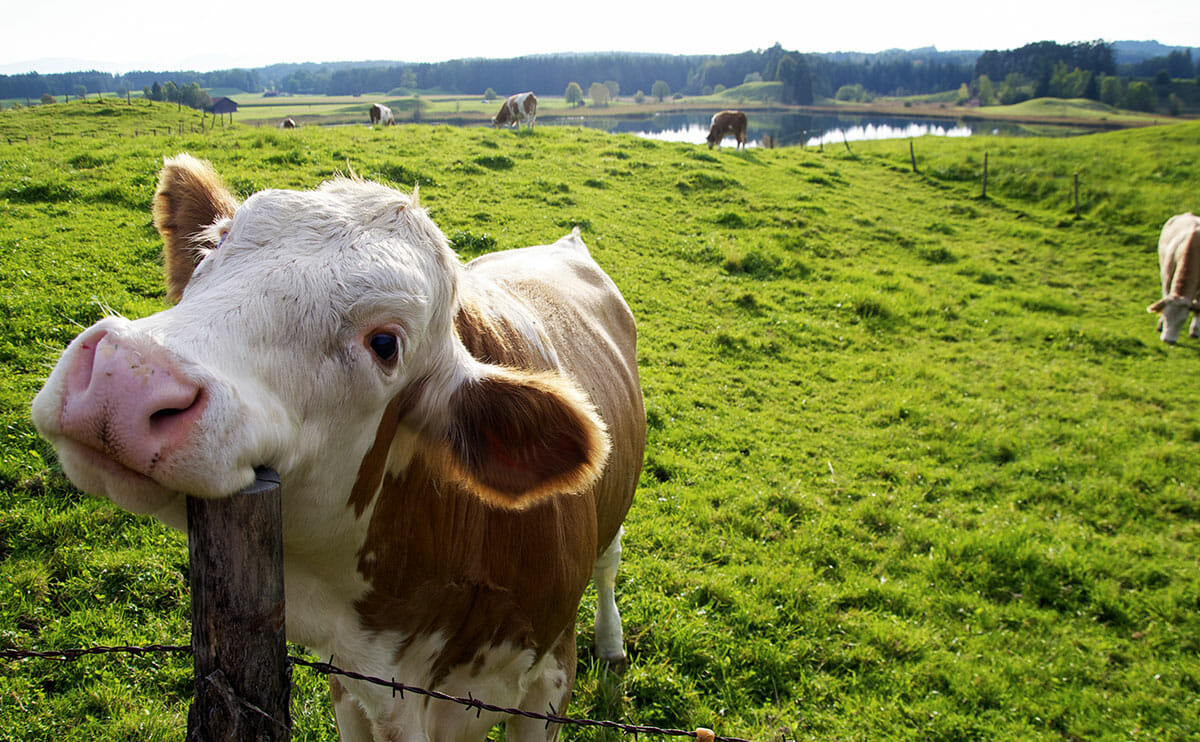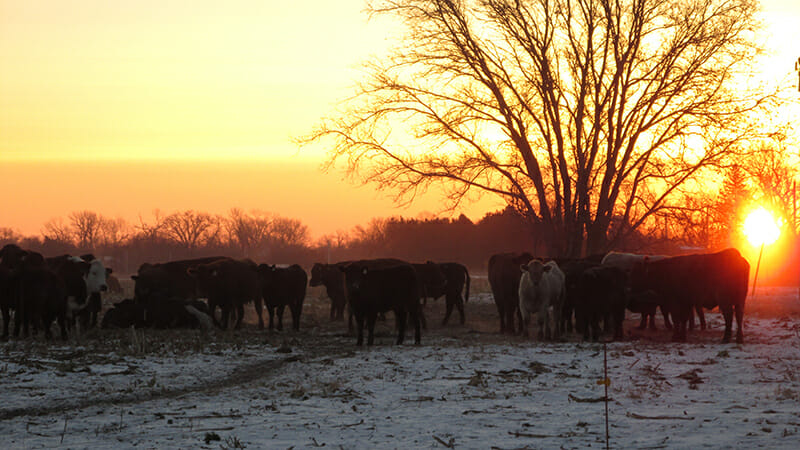Cows' new favorite: turnips.

In the summer this is a seed-corn field, but in winter months, it’s not just corn stubble. Intermixed are bright green — albeit frosty and slightly wilted — plants.
“We do a mix of turnips, tillage radishes and Ethiopian cabbage,” Cast explains.
Turnips, radishes and cover crops in general aren’t necessarily a new phenomenon, but they are gaining a renewed popularity. As Cast explains, there has been a real push from universities and the U.S. Cooperative Extension ”“ a branch of the U.S. Department of Agriculture (USDA) ”“ to work on soil conservation.

Cast’s cows lowing by a tree in the early hours of the morning before going out in the pasture to graze turnips, radishes and Ethiopian cabbage.
This is something at which radishes and turnips excel. The large tubers break up soil compaction, the leafy tops give protection from snow and wind erosion and left-over biomass after grazing provides much-needed organic matter to the soil.
“We would do this even if we didn’t have the cows,” says Cast. “You can’t dig a hole anywhere on this field without turning up earthworms.”
Bruce Anderson, a professor of agronomy and extension forage specialist for the University of Nebraska-Lincoln, is also a proponent of grazing turnips and radishes.
“You do not want to be standing behind a cow that’s been grazing turnips when it coughs.”
“They have excellent feed value and forage quality,” says Anderson.
According to Anderson, producers usually see one and a half to two pounds per day in weight gain ”“ Cast’s gains have been closer to three pounds per day. This makes turnips an excellent addition to grassfed operations where producers want to avoid grains.
It should be noted — these are not small, salad-sized tubers. These are gigantic turnips the size of cantaloupe and radishes, well over a foot in length.
“You’ll see the cows out there with their heads in the air, gnawing on these giant roots,” says Cast.
The cows will select for the green aboveground bits first, then use their noses or hooves to work the bulbs out of the ground. Then, in slobbery glory, they chew on the roots, even in the cold when the bulbs are frozen. They’re like giant, turnip-flavored popsicles.
“We worried about them choking at first,” Cast says, “but it hasn’t been a problem so far.”
Anderson agrees this could be a problem; however, it takes a very specific size and shape for the cows to choke on. Another problem:
“Turnips are very diarrhetic,” Anderson says. “You do not want to be standing behind a cow that’s been grazing turnips when it coughs.”
[mf_mosaic_container columns=”2″ captions=”yes”]
[mf_mosaic_item src=”https://modernfarmer.com/wp-content/uploads/2014/11/turnup1.jpg” number=”1″ caption=”David Cast measures the depth of a hole left by a tillage radish among dried corn stalks in his pasture.”]
[mf_mosaic_item src=”https://modernfarmer.com/wp-content/uploads/2014/11/turnup2.jpg” number=”2″ caption=”Tillage radishes can grow up to 3 feet long leaving behind large holes that aid in aerating the soil and reducing soil compaction.”]
[/mf_mosaic_container]
An easy fix is to plant a mix of turnips with something high in fiber for roughage; an added bonus of the added fiber is that cows can more effectively use the nutrients in the turnips and radishes.
As for their current limited use, Anderson explains that many farmers are apprehensive because turnips and radishes don’t fit well into the traditional cropping system. In the Midwest, most corn and soybean rotations are planted in April and harvested in mid-autumn ”“ while turnips must be planted in August to be ready for November grazing.
Turnips and radishes are just a few of the forage options to try when looking to reduce costs and soil erosion as well as improving performance of both land and livestock. Other options that are gaining popularity include old-fashioned cereal grains, peanuts and other vegetables like cabbages and carrots. Each region in the U.S. is developing its own grazing alternatives to suit its growing season.
On the way back home in Cast’s flatbed pick-up, he talks about the benefits he’s seen from his turnip mix ”“ from increased gains in his cows, to the incredibly low cost to plant and improved soil quality ”“ and his plans for the near future.
Cast has found another benefit to raising, cabbages, turnips and radishes on his farm. “You’ll sometimes find radishes out in the field during planting,” says Cast. “They’re like a dried-out sponge. They just turn to dust in your hand.”
He can just plant directly in to the soil surface; any remaining plant pieces will just turn into dust when he runs it over with the planter in the spring. Dust to dust, turnips.
Where can I buy the turnips seeds mention in this letter?